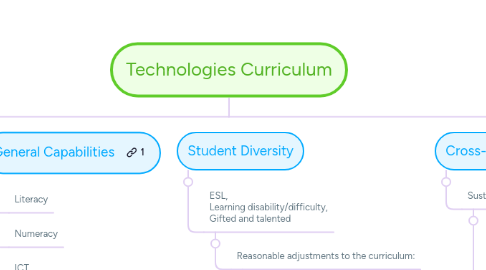
1. Achievment Standards (band levels)
1.1. K-2
1.1.1. Guided play and identifying the purpose of products and how they use them.
1.2. 3-4
1.2.1. Explaining the purpose of products and using ICT for a range of different solutions.
1.3. 5-6
1.3.1. Explaining how digital systems work and describing the competitive industry of technologies.
1.4. 7-8
1.4.1. Distinguishing between different types and purposes of technology and explaining the factors that influence the production of technologies.
2. General Capabilities
2.1. Literacy
2.2. Numeracy
2.3. ICT
2.4. Critical and Creative Thinking
2.5. Intercultural Understanding
2.6. Ethical Understanding
3. Digital Technologies
3.1. Processes and Production Skills
3.1.1. Creating Digital Solutions by...
3.1.1.1. Designing
3.1.1.2. Evaluating
3.1.1.3. Colllaborating & Managing
3.1.1.4. Implementing
3.1.1.5. Defining
3.2. Knowledge and Understanding
3.2.1. Digital Systems
3.2.2. Representations of Data
4. Design Technologies
4.1. Knowledge and Understanding
4.1.1. Technologies Context
4.1.1.1. Application in business and societ
4.1.2. Technologies Society
4.1.2.1. Impact on people's lives
4.2. Processes and Production Skills
4.2.1. Investigating
4.2.2. Generating
4.2.3. Evaluating
4.2.4. Collaboarting
4.2.5. Managing
5. Key Ideas
5.1. Planning
5.2. Designing
5.3. Creativity
5.4. Problem-solving
5.5. Analysing
5.6. Holistic approach
5.7. Systems-thinking
6. Cross-curricular priorities
6.1. Sustainability
6.1.1. '...responding to the designed world, students consider desirable sustainable patterns of living, and contribute to preferred futures for themselves and others.' (ACARA, 2013)
7. Student Diversity
7.1. ESL, Learning disability/difficulty, Gifted and talented
7.1.1. Reasonable adjustments to the curriculum:
7.1.1.1. The way the curriculum is delivered
7.1.1.1.1. Visual
7.1.1.1.2. Auditory
7.1.1.1.3. Kinaesthetic
7.1.1.2. The mode in which assessments are carried out
7.1.1.2.1. ICT
7.1.1.2.2. Verbal
7.1.1.2.3. Observations
7.1.1.2.4. Written
7.1.1.3. Which aspect of the curriculum the learning content is drawn from
7.1.1.3.1. General capabilities
7.1.1.3.2. K-10 curriculum
8. Aims for Digital and Design Technologies
8.1. 'The Australian Curriculum: Technologies aims to develop the knowledge, understanding and skills to ensure that, individually and collaboratively, students:' (ACARA, 2013)
8.1.1. Students should investigate technology, be creative, make informed decisions. & critique and analyse problems
